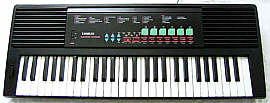 |
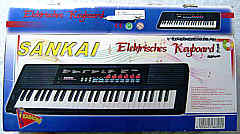 |
This odd fullsize stereo tablehooter (from 1996?) features 30 sample based sounds (including a quite natural piano), programmable rhythm with 6 drumpads and a badly working pitchbend wheel. Great is the incredible disharmonic and detuned sounding chorus and the intense slow vibrato effect. All timbres include some nice analogue distortion.
 |
 |
stereo sound output jacks with speaker mute switch added.
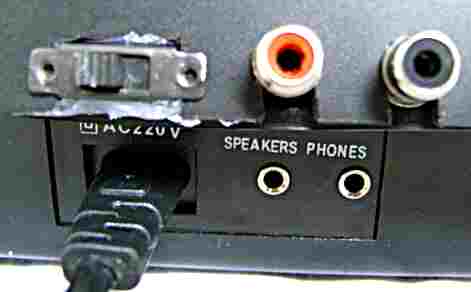
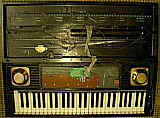 |
 |
 |
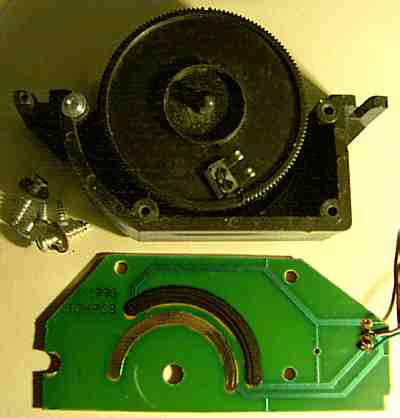 The
pitchbend wheel PCB is marked "8-1996, ITCHPCB". The "8-1996" may be the
development date, while I hope that the "ITCHPCB" doesn't mean that the
wheel was coated with itching- powder but just misspells "PITCHPCB".
The
pitchbend wheel PCB is marked "8-1996, ITCHPCB". The "8-1996" may be the
development date, while I hope that the "ITCHPCB" doesn't mean that the
wheel was coated with itching- powder but just misspells "PITCHPCB".
At all but the lowest volume setting the instrument plays too loud, which is particularly irritating because after power- on or pressing any key after a (faulty?) auto power- off the thing always comes up with almost full volume and it beeps with that volume while turning volume lower, which may disturb neighbours when played tonight in a room with thin walls. It is recommended to add a potentiometer or voltage divider resistors to reduce the volume to a reasonable value.
The Sankai 01504H has some technical and behaviour similarities with the bizarre Jin Xin Toys JX-20165, but employs a different and much more natural sound set with way less zipper noise, although it still includes some aliasing noise. Strange is that on the control panel for some sounds 2 names are listed (like "PICCOLO/ PIPE") although with this instrument always only the 2nd name is valid; apparently there were 2 CPU versions with a slightly different sound set and the case manufacturer didn't know which chip would be installed. Also the drumpads show icons {snare, base, closed cymbal, open cymbal, conga, cowbell} although their sounds are {base, snare, closed cymbal, open cymbal, cowbell, clap}. All sounds are selected by 2 digit numbers through the 6 drumpads, those can be switched by the "page" button between percussion and number entry mode.
The main voice sounds are medium resolution samples; most are short looped waveform samples those sound quite realistic and thus rather boring. All sounds include a dose of analogue distortion (caused by the amplifier?) that is particularly noticeable with polyphonic play. The instrument always adds a mild stereo symphonic effect to the main voice, that quickly pans them left and right like a rotary speaker simulator. The "piano" sound employs 4 split points with different split points and thus sounds quite realistic (although a bit metallic). Also other sounds include split points. The "organ" resembles a reed organ. The "bell" resembles a vibraphone without vibrato. The "music box" has a very long sustain and audible aliasing in high notes. The "jazzguitar" is harsh with a metallic roaring bass range and resembles the famous My Music Center, although it sounds cleaner and thus less extreme. The "acoustic bass/ bass" has with held keys a long sustain phase (rather a Rhodes piano). The "tuba" and "cello" turn thin with higher notes. The "alto sax/ sax" sounds thin and very dry. The "string2/ string" is more a pipe organ and the "accordion" sounds more like a harsh clarinet (the "clarinet" is duller). The "musicbox1" sounds like a bowed glass and has no long release phase. The "whistle" is a dull flute. All sounds have only a simple ADSR envelope and include no vibrato.
The 3 effect buttons are IMO the special key feature of this instrument because they make really bizarre and wonderful lo-fi sounds. The "ECBO" button (misspelled "echo") adds an echo by re- triggering /chopping every note 7 times (about 4Hz) with decaying volume and percussive attack phases. The vibrato button ads a slow square vibrato (4Hz?), which amplitude increases absurdly in the bass range and thus makes the lowest note howl by about 1 semitone. The only other instrument where I heard such an odd vibrato was my defective Tuttivox tube organ. Apparently the modulation algorithm adds a fixed value to the frequency instead of multiplying it with a factor. Strange is also that when with vibrato the same key is pressed multiple times, the vibrato sporadically switches between vibrating up and vibrating down (i.e. it toggles either between the original and a lower or the original and a higher tone), which is particularly audible in the bass range. The "REVERD" button adds a chorus by dubbing the main voice with a detuned suboscillator, and also this one has the same bass "flaw" like the vibrato, i.e. the detuning gets so extreme in the bass range that bass notes sound absurdly cacophonic (similar like the great roaring My Music Center guitar). Unfortunately the 3 effects can not be combined and also don't work together with rhythm.
The pitchbend wheel makes audible raster steps and employs an unusual algorithm; it only bends the notes of already held keys while newly pressed keys always start notes at their default pitch. Likely this was done to prevent detuning the instrument because the CPU is confused by moving the wheel too fast, which makes it forget the previous center value (only because the long cables are unshielded??). Also the wacky carbon trace potentiometer works unprecisely and doesn't return always to its center value. Unfortunately the pitchbend doesn't work together with the preset rhythms (but at least with the programmable user pattern).
The 10 rhythms use a lot of latin percussion samples (many shakers and claps) and resemble rather hiphop or tribal patterns than average home keyboard stuff. The "march" includes a louder fading drumroll that reminds to Kawai keyboards. The Sankai seems to use a different sample set than My Music Center or Medeli MC-32. All percussion are natural drum kit samples of medium resolution, those have different stereo positions in the preset rhythms. Annoying is that the OBS rhythm buttons always reset many functions to default each time a rhythm (or "sync") button is pressed. E.g. they reset the tempo to default, the drumpads to number entry mode and switch the accompaniment off, which is really annoying because it massively limits their use as realtime controls. You can not switch the rhythm without stopping the accompaniment, and even when the accompaniment is immediately manually restarted, it always waits until the end of the current rhythm pattern before it sounds again. At least all rhythms itself can be started and rapidly retriggered by pressing their buttons rapidly. With rhythm off all button presses make a loud beep.
The single finger accompaniment (labelled "SINGLE") knows only 3(?) chords and also in fingered chord mode (mislabelled "PINGER") only a few standard chords can be played. The accompaniment consists of e-bass and usually sweetish pop organ chords, and the styles are quite over- orchestrated and thus less versatile. Most styles resembles reggae and contain some sweetish pop arpeggio. By the limited choice of chords they can never sound nasty or disharmonic and also react a bit slow on chord changes. There are sometimes strange glitches those make polyphonic main voice notes interfere with the accompaniment. (E.g. accompaniment notes temporary get louder or change timbre).
Like the Letron MC-3 (see there) and many similar instruments, also the Sankai 01504H has a programmable (monophonic) drum pattern, but this one is quite restricted because it can not be used together with accompaniments and not even the synchro and fill-in buttons work. You can only retrigger the user pattern with the "play" button, but stopping it by any means (the only way to enable normal rhythms and accompaniment again) always deletes the pattern. At least the pitchbend wheel still works during this. The user pattern is programmed by pressing "rhythm edit" and then entering a sequence of drumpad button presses or "play" for pauses until the entered percussion is not played anymore. Then press "play" to start. The pattern seems to be always 16 steps long. (With other such instruments the length depends on the previously selected rhythm; e.g. "waltz" would normally cause a 12 step pattern.) Unlike preset rhythms, the custom pattern and drumpads play always mono (centered position).
The instrument has 7 complex orchestrated polyphonic demo melodies, but some patterns of them sound quite disharmonic:
The Sankai 01504H was also released with different button colours
(like shown on the box). A variant and possible direct successor of the
Sankai
01504H hardware was the pretty red
K-Mark
toy keyboard (the likely only keyboard with 49 mini keys), which has very
similar sounds and rhythms but different controls. I am not sure whether
this hardware was the most advanced descendant of the My
Music Center hardware family or if it was developed independently.
Other non- toy instruments with similar digital lo-fi sound effects are
the Medeli MC-32 and the bizarre
Jin
Xin Toys JX-20165. A modern successor of the Sankai 01504H
hardware family may be the boring sounding First
Austria MC-36 (with 49 midsize keys and MIDI- out), which was even
redistributed by Casio as MA-150/ MA-170.
| removal of these screws voids warranty... | ||
 |
||
|
|